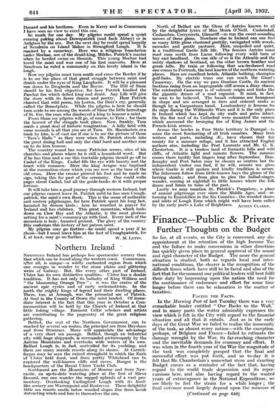Northern Ireland - NORTHERN Ireland has perhaps less spectacular scenery
than that which can be found along the western coast. Connemara, c"ter all, is unique—a wildly enchanted region from which one emerges in wonder to the stone plains and- glittering weirs of Galway. But, like every other part of Ireland, Ulster has its own distinctive qualities.• Ulster has a double tradition. It has not only its balladry of King William and " the blossoming Orange Tree " ; it was the centre of the ancient epic cycles and of early ecclesiasticism. In the north the mighty kings of legend had their dwelling places. There, too, at Armagh, was the primatial see of Patrick. At Saul in the County of Down the saint landed. Of imme- diate interest is the fact that this year in October a Com- memoration will be held by the Church of Ireland at that little fishing village. Eminent Celtic scholars and artists are contributing to the pageantry of the great religious gathering. Belfast, the seat of the Northern Government, can be reached by several sea routes, the principal are from Heysham and from Stranraer. Many will appreciate the advantage of a very short sea passage. Belfast, though an industrial city with huge shipyards, is surrounded,picturesquely by the Antrim Mountains and overlooks wide waters of its own. Belfast Lough is, in fact, unrivalled for its yachting, and there are many seaside resorts along its shores. At Carrick- fergus may be seen the ruined stronghold in which the Earls of Ulster held feast, and from pretty Whitehead can be explored the well-known cliffs and caves. Bangor is the headquarters of the Royal Ulster Yacht Club.
Southward are the Mountains of Mourne and from New- castle, an up-to-date watering place at the foot of Slieve Donard, one can wander the rugged uplands of a vast pro- montory. Overlooking Carlingford Lough with its fiord- like scenery are Warrenpoint and Rostrevor. These delightful little sea resorts nestle below wooded slopes free from harsh distracting winds and lure to themselves the sun. North of Belfast are the Glens of Antrim known to all by the delightful lyrics of Miss Moira O'Neill. Cushendall, Cushendun, Corryineela, Glenariff—so run the sweet-sounding names of these glens. Nowhere else in Ireland can one find so many little glens clustered prettily, variegated with woods, cascades and gentle pastures. Here, unspoiled and quiet, is a traditional Gaelic folk life. The famous Antrim coast road runs north Irons Lame following every wild turn of bay and headland. On one side of us is the Atlantic and the misty shadows of Scotland, on the other brown heather and green hills. By train or following that sea-freshened road one comes to Portrush, the best known of the northern watering places. Here are excellent hotels, Atlantic bathing, champion golf-links. By electric trans one can reach the Giant's Causeway. On the way we pass Dunluce Castle, its ancient bastions rising from an impregnable cliff across a dizzy.chasm. The celebrated Causeway is of volcanic origin and looks like the gigantic dream of a mad organist. It must, in fact, be seen to be believed. The basalt columns are hexagonal in shape and are arranged in tiers and ordered ranks as though by a Gargantuan hand. Londonderry is famous for its siege during the Williamite Wars and it is the only place in Ireland which has kept its city walls and gates intact. On the fiat roof of its Cathedral were mounted the cannon which answered the besieging fire of King James and the French-Irish armies.
Across the border in Free State territory is Donegal—to some the most fascinating of all Irish counties. Many Irish writers and poets, including 2E. have chosen that fair county for a summer refuge, and it has attracted English authors also, including the Poet Laureate and Mr. G. K. Chesterton. It is a treeless land of fantastic hills and wild cliffs, of Atlantic light and minute flowers. The summer comes there tardily but lingers long after September. Dun- fanaghy and Port Salon may be chosen as centres but the independent visitor can find, if he will, remote sea glens where Gaelic is still spoken and kindly tradition is secure. The fishermen follow from little-known bays the gleam of the herring shoals ; and from - glen to glen the . ballad-singers wander, coming at nightfall to little houses where the folk
dance and listen to tales of the past. -
Lastly- we may mention St. Patrick's Purgatory, a place of annual pilgrimage ever since the Middle Ages, and—re- turning to Enniskillen in the Six Counties—the wooded shores and islets of Lough Erne which might well have been called by the early poets a Lake of Brightness..“.US L-
IN ,LARKE.






































 Previous page
Previous page